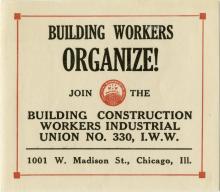The American commercial artist Ralph Chaplin (1887-1961) was one of the first to have produced stickers (then called “stickerettes” or “silent agitators”) during the early 1910s for the Industrial Workers of the World, according to Mark van Wienen in Partisans and Poets: The Political Work of American Poetry in the Great War. By the spring of 1917, a million stickerettes had been printed and distributed, with another three million to be printed by May Day that year and 65,000 stickerettes in other foreign languages. Van Wienen writes, “Stickerette mania grew so intense that a poem in [the I.W.W. weekly] Solidarity, ‘Stick ‘Em Up,’ dubbed May Day ‘Stickerette Day’.”
- "Now all the bosses and their stools will think they’re out of luck, To see the spots of black and red where Stickerettes are stuck; And after they have scratched them off and shook their fists and swore, They’ll turn around to find again another dozen more. Upon the back of every truck, on packages and cards, Upon the boats and in the mines and in the railroad yards, From Maine to California and even further yet, No matter where you look you’ll see a little Stickerette!"
By September of 1917, however, Chaplin and others in the I.W.W. were arrested under the U.S. Espionage Act on charges of sedition. The Espionage Act was passed just after the United States entered World War I. The New York Tribune ran an article, “I.W.W. Beaten in Two Attempts to Rule Out Evidence: Judge Permits Introduction of Pamphlets to Prove Sabotage” (May 7, 1918), which described, “William Cahill, member of a job printing establishment in Chicago, testified that he had printed more than 1,500,000 stickerettes for the I.W.W. These were designed by Ralph Chaplin, one of the defendents, whose pen name is ‘Bingo.’ Many of them advocated sabotage.” Stickerettes are also mentioned in an essay entitled “Here Come the Wobblies!” by Bernard A. Weisberger for the American Heritage (1967, Volume 18, Issue 4), where he paints a lively picture:
“The I.W.W. reached [the migrant worker] where he lived: in the hobo ‘jungles’ outside the rail junction points, where he boiled stew in empty tin cans, slept on the ground come wind, come weather, and waited to hop a freight bound in any direction where jobs were rumored to be. The Wobblies sent in full-time organizers, dressed in the same caps and windbreakers, but with pockets full of red membership cards, dues books and stamps, subscription blanks, song sheets, pamphlets. These job delegates signed up their men around the campfires or in the boxcars (‘side-door Pullmans’ the migrants called them), mailed the money to headquarters, and then followed their recruits to the woods, or to the tents in the open fields where the harvest stiffs unrolled their bindles after twelve hours of work in hundred degree heat without water, shade, or toilets. But there were some whom the organizers could not reach, and the I.W.W. sent them messages in the form of ‘stickerettes.’ These ‘silent agitators’ were illustrated slogans on label-sized pieces of gummed paper, many of them drawn by Ralph Chaplin. They sold for as little as a dollar a thousand, and Chaplin believed that in a few weeks a good ‘Wob’ on the road could plaster them on ‘every son-of-a-bitch of a boxcar, water tank, pick handle and pitchfork’ within a radius of hundreds of miles.
The stickers were simple and caught the eye. ‘What Time Is It? Time to Organize!’ shouted a clock. ‘Solidarity Takes the Whole Works,’ explained a Bunyan-sized workingman with an armload of trains and factories. The three stars of the One Big Union (Organization, Education, Emancipation) winked bright red over a black and yellow earth. A ‘scissorbill’—a workingman without class loyalty—knelt on bony knees and snuffled to the sky, ‘Now I get me up to work, I pray the Lord I may not shirk.’ But the most fateful stickers to appear between 1915 and 1917, as the nation moved toward war, were those that urged: ‘SLOW DOWN. The hours are long, the pay is small, so take your time and buck ’em all’; and those on which appeared two portentous symbols: the wooden shoe of sabotage, and the black cat, which, as everybody knew, meant trouble.”
The Robert F. Wagner Labor Archives at New York University’s Tamiment Library contains close to 30 original stickerettes. Some in the collection were used as early as the 1910s, while a later one referred to the fighting in Viet Nam (sic). An exhibition entitled “Wobbly” 80 Years of Rebel Art was held at the Labor Archives and Research Center in San Francisco in 1987. The exhibition catalogue identifies some of the artists who made these stickers (William Henkelman, for example, a sign painter by profession), though most of the creators weren’t artists at all (C.E. Setzer, a.k.a. “CES” or “X13,” was a construction worker on the Los Angeles aqueduct). According to the catalogue, “The I.W.W. pioneered the use of these little pieces of gummed paper. Over the years countless different ones in a variety of sizes were produced in quantities that must total in the millions. Old and new, they are still in use by the I.W.W. as a simple, succinct method to spread ideas or just to generally raise the consciousness of the passerby.”
Most stickerettes are printed in black and/or red on lightweight sheets of paper. Some have a light adhesive gummed backing, while others are simply meant to be licked and slapped onto a clean surface.
-March 3, 2016










